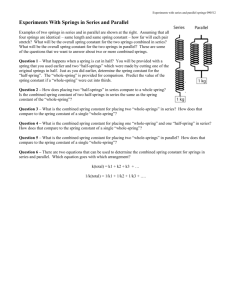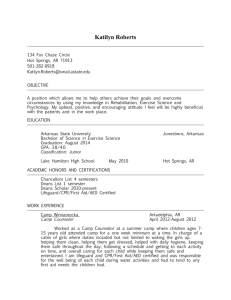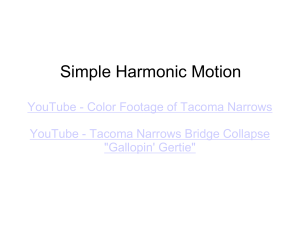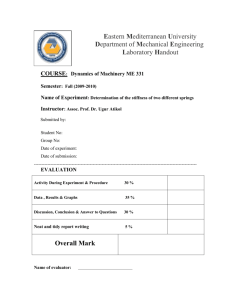Springs For Die Pressure
advertisement
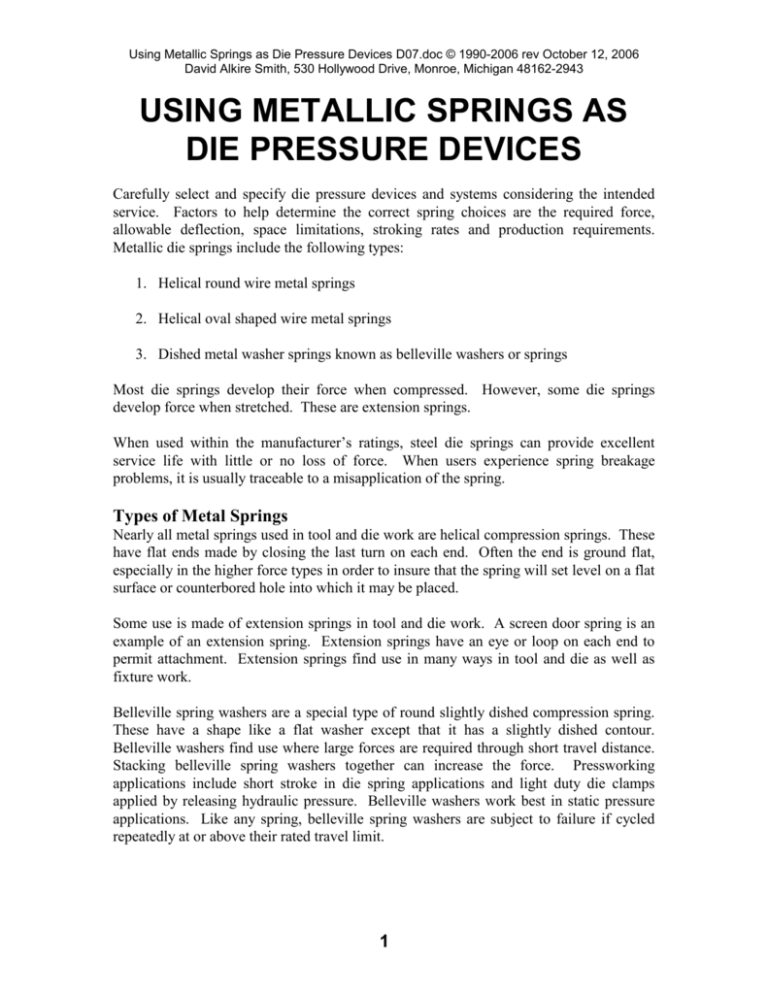
Using Metallic Springs as Die Pressure Devices D07.doc © 1990-2006 rev October 12, 2006 David Alkire Smith, 530 Hollywood Drive, Monroe, Michigan 48162-2943 USING METALLIC SPRINGS AS DIE PRESSURE DEVICES Carefully select and specify die pressure devices and systems considering the intended service. Factors to help determine the correct spring choices are the required force, allowable deflection, space limitations, stroking rates and production requirements. Metallic die springs include the following types: 1. Helical round wire metal springs 2. Helical oval shaped wire metal springs 3. Dished metal washer springs known as belleville washers or springs Most die springs develop their force when compressed. However, some die springs develop force when stretched. These are extension springs. When used within the manufacturer’s ratings, steel die springs can provide excellent service life with little or no loss of force. When users experience spring breakage problems, it is usually traceable to a misapplication of the spring. Types of Metal Springs Nearly all metal springs used in tool and die work are helical compression springs. These have flat ends made by closing the last turn on each end. Often the end is ground flat, especially in the higher force types in order to insure that the spring will set level on a flat surface or counterbored hole into which it may be placed. Some use is made of extension springs in tool and die work. A screen door spring is an example of an extension spring. Extension springs have an eye or loop on each end to permit attachment. Extension springs find use in many ways in tool and die as well as fixture work. Belleville spring washers are a special type of round slightly dished compression spring. These have a shape like a flat washer except that it has a slightly dished contour. Belleville washers find use where large forces are required through short travel distance. Stacking belleville spring washers together can increase the force. Pressworking applications include short stroke in die spring applications and light duty die clamps applied by releasing hydraulic pressure. Belleville washers work best in static pressure applications. Like any spring, belleville spring washers are subject to failure if cycled repeatedly at or above their rated travel limit. 1 Using Metallic Springs as Die Pressure Devices D07.doc © 1990-2006 rev October 12, 2006 David Alkire Smith, 530 Hollywood Drive, Monroe, Michigan 48162-2943 Other types of springs include spiral springs and flat leaf springs. These types find some use in die applications. A typical use for a leaf or flat spring is to actuate a progressive die positive type-starting stop. Materials Used to Make Metal Springs Plain carbon steel springs are the least costly and are suitable for low deflection applications and/or light duty applications. If deflection is limited they may last for a long time without failure. Chrome vanadium alloy steel springs, while slightly higher-priced than those of carbon steel, can last three or more times as long. When selecting die springs for a die design, the best performance and reduced down time are ensured by use of chrome-vanadiumsteel springs, and derating the travel from the maximum deflection recommended by the manufacturer to that recommended for long life. Other spring materials include stainless steel and a variety of special alloys including those developed for watch hairsprings and mainsprings. An example of a special spring alloy is Elgiloy™ developed by the Elgin Watch Company. It is nonmagnetic, very fatigue resistant and the spring force changes very little over a wide temperature range. These materials are very useful for instrument springs and applications involving a corrosive environment. The best die spring steels require careful processing throughout each manufacturing step. This careful processing may include, in part, the following good practices: 1. Vacuum degassing of the molten metal. 2. A continuous casting process carefully controlled to insure uniformity of the rod used to form the spring wire. 3. Careful process control to draw or roll the wire to the desired shape and size without atmospheric decarburization, contamination, or unwanted inclusions of oxides or slag. 4. Use of the best winding and shaping practices to avoid stress concentration or stress risers that may lead to crack formation, propagation, and early failure. 5. State of the art heat-treating practices to correctly harden the steel and draw it to the correct spring temper. 6. Shot peening of the formed and heat-treated spring surface to leave the surface in the most desirable state of residual compressive stress. 7. Presetting by compressing to a solid condition to increase set resistance and fatigue life. 2 Using Metallic Springs as Die Pressure Devices D07.doc © 1990-2006 rev October 12, 2006 David Alkire Smith, 530 Hollywood Drive, Monroe, Michigan 48162-2943 Compression Springs Most metal springs used in die construction are compression springs. Compression springs for strippers, pressure pads, and other spring operated die components can be selected from the ratings given in terms of the amount of force per unit of travel. Obtain this data from manufacturer's catalogs. Round wire springs are suited very light duty pressure pad applications because of their low load ratings. They are still a good choice for such applications as latch return springs and for use in progressive die starting stops. Compression die springs made from steel wire having an oval or a special trapezoidal cross sectional area are designed for high forces together with long service. Winding wire into a helical spring involves bending the metal. The inside of the helix goes into compression while the outside stretches. Wire with a trapezoidal cross section having smoothly rounded corners is favored by at least one spring manufacturer because the small end of the trapezoidal shape is used to form the inside of the spring helix. This cross sectional shape is easier to wind since the small part of the trapezoidal cross section is easier to compress than the thicker edge of an oval wire having an equal width and cross sectional area. The result is a spring having less residual tensile stress on the outside of the helix and a more uniform cross sectional area than would otherwise be the case with oval wire spring stock. Compression Spring Ratings Helical steel die springs are available in several load ratings or amounts of allowable deflection expressed as a percentage of the uncompressed or free length and amount of force developed per incremental unit of deflection. While the quality of steel used to make springs is an important factor in their service life, the amount of allowable deflection is mainly a function of the thickness of the round, oval or trapezoidal wire used to form the spring. However, springs made of thicker material have substantially lower allowable percentages of total deflection for the same material stress levels. Cycling a spring by repeatedly deflecting it at high stress values will eventually cause the spring to develop fatigue cracks and eventual failure. Greater wire size or thickness equals greater force developed per unit of deflection. However, the operating stresses developed in the spring material increase with the diameter or thickness of wire used. Therefore, springs wound from thick material develop higher forces per unit of deflection than those made of thinner material. 3 Using Metallic Springs as Die Pressure Devices D07.doc © 1990-2006 rev October 12, 2006 David Alkire Smith, 530 Hollywood Drive, Monroe, Michigan 48162-2943 ISO Standard Spring Rating Color Coding Spring Load Rating ISO Color Code Light Duty Green Medium Duty Blue Heavy Duty Red Extra Heavy Duty Yellow Table 1. International Standards Organization (ISO) standard color codes for die spring load classes. These standards adopted by the North American Automotive Metric Standards Group apply to springs made to metric standards. An Unfortunate Source of Difficulty for the Diemaker and Designer One would suppose that the ISO spring color-coding standard is an industry wide standard for color-coding springs to identify their load or duty rating. Such a system would seem highly logical in view of the adoption of this standard by both ISO and the North American Automotive Metric Standards Group (NAAMS), which is a working group of The Automotive Steel Partnership. Unfortunately, a simple matter such as adopting the European and North American International industry standard of uniform identification of the load rating of die springs is not agreed upon by all manufacturers. Non-standard color-coding of springs includes colors that do not correspond to the actual duty class so identified and even springs having two-tone paint schemes. All of this can result in confusion and may even result in a dangerous die condition should an incorrect duty class spring fail in an unexpected way that might endanger personnel. To further complicate matters, Japan, although a metric standard country, has a non-ISO standard for die springs. From a diemakers point of view, there is enough difficulty in designing and maintaining tooling without difficulty in identifying the duty class of a spring die to variant colorcoding schemes. Hopefully, the combined efforts of the North American based automakers and ISO will force acceptance of common spring identification and rating standard. 4 Using Metallic Springs as Die Pressure Devices D07.doc © 1990-2006 rev October 12, 2006 David Alkire Smith, 530 Hollywood Drive, Monroe, Michigan 48162-2943 Figure 1. ISO standard spring rating color-coding. The Danly Die Set Division of Connell Limited Partnership Selecting Springs Step by Step 1 For a known spring diameter and length, you may refer directly to spring manufacturer’s dimension tables to select springs with the desired total force or load capacity. However, if the required diameter and length are not known you may use a proven step by step spring selection process in order to determine the compression percentage, life expectancy, and deflection Vs load from the manufacturer’s catalog data. There are seven steps to the process. Spring Considerations when Repairing Dies When repairing dies that do not have enough spring force or are experiencing excessive spring breakage this systematic process can help pinpoint the problem. In determining the length of a spring, remember that higher spring forces require selecting larger diameter and higher load class springs. 1 Based on the spring selection instructions in the Danly® Die Set Division of Connell Limited Partnership Die Springs Catalog © 1996 and prior dates. 5 Using Metallic Springs as Die Pressure Devices D07.doc © 1990-2006 rev October 12, 2006 David Alkire Smith, 530 Hollywood Drive, Monroe, Michigan 48162-2943 For best economy and saving of space, choose Light and Medium Load springs or the Heavy Load spring having a free length equal to six times the travel. If an Extra Heavy Load spring is required, use a free length equal to eight times the travel. If ratios lower than these are used because of height limitations, the number of springs required will be substantially increased. In such cases, self contained nitrogen gas springs should be considered an alternative. A Seven Step Spring Selection Process Step One Estimate the level of production required of the die. This should determine the allowable deflection. Short run dies where spring breakage is expected to occur may use deflections such as the average or maximum deflection. Long run dies and tooling in constant production should not be deflected more than the long life percentage. Step Two Determine compressed spring length “H” and operating travel “T” from the die print layout. These dimensions may be measured if the die is open on the repair bench. These dimensions are shown in Figure 2. Figure 2. Combined formula diagram illustrating the factors needed to determine spring selection in steps one through six. The Danly Die Set Division of Connell Limited Partnership Step Three Determine free length “C” as follows: Decide which load classification from which the spring should be selected. Normally, this involves choosing from Light, Medium, Heavy, or Extra Heavy Load. Then choose the figure nearest the compressed length “H” required by the die design from the appropriate charts supplied by the spring manufacturer. Take note of the corresponding “C” dimension, which is the free length of the spring as shown in Figure 2. 6 Using Metallic Springs as Die Pressure Devices D07.doc © 1990-2006 rev October 12, 2006 David Alkire Smith, 530 Hollywood Drive, Monroe, Michigan 48162-2943 Step Four Nearly all die springs used in pressure pad and cam return applications are precompressed or preloaded in order to have useful force throughout their working stroke. The next step is to estimate the total initial spring load “L” required for all springs when the springs are preloaded or compressed “X” inches or millimeters. This is also illustrated in Figure 2. Step Five Determine “X” or initial compression by using equation 1 which is the following formula: X = C - H -T (equation 1) Where: X = Initial spring compression or preload C = The relaxed or free length of the spring H = The maximum compressed length of the spring during die operation T = The operating travel when installed in the die Figure 2 illustrates how the “X”: dimension or initial compression produces a calculable force or load “L” which is determined from the spring manufacture’s data. Both the “H” dimension which is the compressed length and the “T” dimension which is the operating travel are subtracted from the “C” dimension which is the unloaded free length of the spring. Of course the “X” value or initial spring preload of the total number of springs must be sufficient to provide adequate pressure for stock control upon initial pad or stripper contact as the die closes. The same is true of stripping pressure as the die opens. A safety factor to allow for expected punch metal pickup or galling is needed to insure dependable operation before scheduled bench die maintenance. Step Six Inch Formula: Determine “R” (total rate for all springs in pounds per 1/10 inch) by using equation 2 which is the following formula: L R = ——— 10 x X 7 (equation 2) Using Metallic Springs as Die Pressure Devices D07.doc © 1990-2006 rev October 12, 2006 David Alkire Smith, 530 Hollywood Drive, Monroe, Michigan 48162-2943 Where: R = Total rate for all springs in pounds per 1/10 of travel or deflection L = Load when springs are compressed “X” inches. X = Initial compression preload in inches. Metric Formula: Unfortunately, there are at least two metric systems in use. European and North American manufacturers generally adhere to a system for spring force based on Newtons per millimeter. A Newton is equal to a force of 0.2248 pounds. In order to determine the value “R” which is the total spring rate for all springs used under a pad or other die application, a different formula than for inch units is used. To determine the spring rate for all springs used in an application such as a spring pad pressure or cam return forces in Newtons per millimeter use equation 3 which is the following formula: L R = ——— X (equation 3) Where: R = Total rate for all springs in Newtons per millimeter of travel or deflection L = Load in Newtons for all springs X = Initial compression preload measured in millimeter increments Step Seven: Select the Correct Springs First, the free length of the spring “C” illustrated in Figure 3 must comply with the length determined in Step 3. Next, divide “R”, determined in step six which is the total spring rate by the total number of springs to be used in order to get the rate per individual spring. It is often not possible to know this number with certainty since the spring diameter is not yet determined. How and where springs can be placed around die details under die pressure pads and in other limited die space applications must be determined. The required spring diameter and allowable deflection depending on the duty class of spring needed are determining factors in making the selection. 8 Using Metallic Springs as Die Pressure Devices D07.doc © 1990-2006 rev October 12, 2006 David Alkire Smith, 530 Hollywood Drive, Monroe, Michigan 48162-2943 Once the number of springs and spring rate is determined, refer to the manufacturer’s catalog to choose springs having the desired rate. If the number of springs is not known, divide “R” from Step 6 by the rate of the spring you select for the correct number of springs. Spring Duty Class and Allowable Compression Table 2 lists data for the maximum allowable deflection recommended for four different ISO die spring classifications. This is based on spring design for long life, average life, as well as maximum allowable deflection. MAXIMUM ALLOWABLE SPRING DEFLECTION VS RELATIVE SPRING LIFE ISO LIGHT LOAD ISO MEDIUM LOAD COLOR CODE GREEN COLOR CODE BLUE ALLOWABLE DEFLECTION ALLOWABLE DEFLECTION LONG AVERAGE MAXIMUM LONG AVERAGE MAXIMUM LIFE LIFE DEFLECTION LIFE LIFE DEFLECTION 25% 30% 40% 25% 30% 37.5% ISO HEAVY LOAD ISO EXTRA HEAVY LOAD COLOR CODE RED COLOR CODE YELLOW ALLOWABLE DEFLECTION ALLOWABLE DEFLECTION LONG AVERAGE MAXIMUM LONG AVERAGE MAXIMUM LIFE LIFE DEFLECTION LIFE LIFE DEFLECTION 20% 25% 30% 17% 20% 25% Table 2. Maximum allowable deflection recommended for four different ISO die spring classifications based on design for long and average life as well as maximum allowable deflection. In cases where high initial compression is required, high-pressure nitrogen cylinders or hydraulic pressure systems may be required. Both nitrogen and hydraulic die pressure systems have the advantage of providing high forces upon the initiation of travel. On other words, an initial compression, which uses up available spring travel, is not needed. The required pad and cam return forces should be carefully calculated during the die design process. Springs are often the best choice from a cost and reliability standpoint. However, if extremely high forces are required, nitrogen and hydraulic systems should be specified. Mixing or Replacing Springs with Self Contained Nitrogen Cylinders In the event that the die as designed and built fails to have enough pad or cam return force, self contained nitrogen cylinders are available that are size for size compatible with many popular die springs. Replacing some or all of the die springs with self contained nitrogen cylinders can serve to increase both the initial contact force and total system force. 9 Using Metallic Springs as Die Pressure Devices D07.doc © 1990-2006 rev October 12, 2006 David Alkire Smith, 530 Hollywood Drive, Monroe, Michigan 48162-2943 Replacing springs with self-contained nitrogen cylinders is not a simple substitution process. In many cases, provision must be made for a hard wear surface for the nitrogen cylinder rod bearing surface. This can involve substantial modification of the die, especially if the cylinder rod end is in line with a pilot hole used to counterbore a spring pocket. Depending on die geometry, the hole may need to be fitted with a hardened insert or a wear surface of air hardening weld overlayment provided. Spring Mounting and Care The locating and mounting of springs in pockets around pilots or bolts, in tubes, or by other methods are determined by space available, service requirements and malfunctioning through slug interference, misalignment or other causes. Springs must be well supported in a hole, over a rod or stripper bottom guide them adequately under stress. Lack of support can result in crushing, twisting, binding, or surface wear. 2 When springs are set in holes, the bottom of the hole should have a flat bottom to provide a flat seat and eliminate the possibility of crushing or deforming the ends. The edges of the holes should have a small chamfer to prevent interference with the movement of springs. However, if the unguided length of the spring is greater than the diameter, a center guide rod should be used. The guide rod also serves to retain the broken pieces should the spring fail. Tubular steel spring cages or cans placed around the spring as illustrated in Figure 3 are a good alternative for a rod to guide the spring. The can or cage serves several important purposes. It helps prevent the entry of dirt and debris into the spring pocket. Dirt caused by flaking of protective material coatings is especially a problem with dies used to work galvanized steel. Another important function of placing spring cages or cans around springs in bored pockets is to retain any broken pieces of failed springs. This is especially important if there is a possibility of a spring fragment flying and causing personal injury. Another consideration in retaining pieces is to prevent them from causing interference in pads that bottom out. Good quality spring cans have a hard surface treatment for wear resistance. They are available in a variety of outside diameters and lengths. The hole (H) is sized to accommodate a shaft or rod if desired. 2 D. Smith, Die Design Handbook, Section 22, Die Sets and Components, © the Society of Manufacturing Engineers, Dearborn, Michigan, 1990. 10 Using Metallic Springs as Die Pressure Devices D07.doc © 1990-2006 rev October 12, 2006 David Alkire Smith, 530 Hollywood Drive, Monroe, Michigan 48162-2943 Figure 3. A spring cage or can used to keep debris out of spring pockets and contain any broken spring pieces in the event of spring failure. The Danly Die Set Division of Connell Limited Partnership Analysis of Metal Spring Failures Properly selected and used, metal die springs provide long trouble free service. If die springs fail frequently, then there is a reason and normally an alternative is available to reduce or eliminate the failure rate. Misconceptions Concerning Metal Spring Failures In conducting both public and in-plant training, the writer asks the class attendees if they are having problems with die springs breaking. The answers range from hardly ever does a spring break to broken springs are a serious downtime, cost and safety concern. The next logical question to ask is how many attendees have problems with the valve springs in their automobile engines breaking. With the exception of a very few persons who have exceeded the mechanical endurance of valve springs in racing engines, the usual answer is virtually no one has a problem with automotive valve springs breaking. Die engineering is solidly based on mechanical engineering principles. Any mechanical failure has a cause and in most cases a straightforward solution. The automotive valve spring comparison leads to a sensible conclusion. Since both valve springs and die springs are made of similar high quality steel, then die springs that fail must be excessively stressed. A source of confusion is the tendency of a few manufacture’s of both die springs and die nitrogen cylinders to use negative comparisons of competing products in their advertising literature. In the writer’s opinion, there is a best application for each type of die pressure system. 11 Using Metallic Springs as Die Pressure Devices D07.doc © 1990-2006 rev October 12, 2006 David Alkire Smith, 530 Hollywood Drive, Monroe, Michigan 48162-2943 Table 2 illustrates how die springs are rated for maximum deflections based on the required life expectancy. If die springs are deflected beyond the long life rating, it is assumed that spring failure is likely to occur and failure should be expected. While automobile designs vary, engines operate at approximately 2,000 revolutions per minute at highway cruising speeds. Therefore, a four-cycle engine would undergo 1,000 spring compressions per valve during each minute of operation. Thus, automotive die springs routinely withstand well over 100,000,000 compression cycles during the conservatively rated nominal life of the engine. High-speed pressworking is accomplished at speeds of from 300 to over 2,000 strokes per minute (SPM). A typical speed for an electrical connector die is 1,200 SPM. Such dies will complete over a million hits in a typical 16-hour two-shift operation. In such costly precision tooling, spring breakage could result in catastrophic damage. Winding Springs in House Many tool and die makers are taught how to wind springs as part of their apprenticeship training. The usual material for springs made in the toolroom is music spring wire. This material is also commonly known as piano wire, although the term music spring wire is the correct term for the commercial product. Winding spring wire onto an arbor in a lathe is one way to make springs in the toolroom. A hazard to be aware of is that a finger or other body part may become entangled in a loop of the wire as it is fed into the lathe. Should this occur, serious injury such as an amputation can result. Commercial spring winding machines are used in a few large toolrooms that need a variety of special springs on short notice. This in house ability is especially handy if prototype or jig and fixture work requires the development of special springs. Some spring winders are hand cranked and can be operated by a single individual. This greatly reduces the possibility of injury. Appropriate safety equipment such as approved safety glasses should always be worn to avoid injury when working with springs. In general, the use of springs that are catalog items will help insure that the spring will meet the engineering specifications of the manufacturer. However, for prototype and instrument work, the knowledge and equipment to wind a special spring quickly is a valuable skill. Appropriate Use of Metal Springs The use of coiled metal die springs is one of the most widespread die pressure system applications. Readily available engineering data predicts that metal fatigue will not cause failure problems if springs are carefully manufactured and not over deflected. In general, designing total deflections including initial compression for preloading below the manufacturer’s recommendations for long life will result in long trouble free die pressure service. 12 Using Metallic Springs as Die Pressure Devices D07.doc © 1990-2006 rev October 12, 2006 David Alkire Smith, 530 Hollywood Drive, Monroe, Michigan 48162-2943 There is an obvious need for North American manufactures to adopt the ISO color code designations as their internal standards for duty class, which is also the standard of the North American Automotive Metric Standards Group. Maintaining tooling to meet low inventory reliability requirements makes standardized procedures a necessity. If your company adheres to ISO spring standards, any tooling built in non-ISO countries should be built to ISO standards to avoid maintainability problems. Designing dies with metal spring deflections greater than those specified for long life is advised only for tooling designed with redundant springs and an absolutely fool proof means to contain broken springs and spring attachments such as cam return rods. This is advised to avoid the potential for personal injury and unscheduled downtime. In general, spring deflections greater than those specified for long life are apt to fail in service. This is almost a certainty if the maximum deflection rating is chosen. Common Errors That Result in Coiled Die Spring Failure Most spring failures result from excessive deflections, which cause stress-cracking leading to rapid failure. A partial listing of bad shop practices includes: 1. Replacement of springs with a higher load class resulting in deflections in excess of the die design criteria leading to stress cracking failures. 2. Using the wrong load class spring due to a color-coding error. 3. Failure to specify that spring suppliers follow the widely accepted ISO standard color coding system—include this requirement in your die construction standards and contractually insist that all vendors follow your standards. 4. Neglecting to specify that tooling construction sources use ISO standard springs and that the deflections are specified for the desired life expectancy—if there is doubt, require that a copy of the spring suppliers invoice be supplied. 5. Shortening die springs with abrasive cutoff wheels or cutting torches—this does not provide a flat surface on the end of the spring resulting in lateral bowing. NOTES: _____________________________________________________ _____________________________________________________________ _____________________________________________________________ _____________________________________________________________ _____________________________________________________________ 13 Using Metallic Springs as Die Pressure Devices D07.doc © 1990-2006 rev October 12, 2006 David Alkire Smith, 530 Hollywood Drive, Monroe, Michigan 48162-2943 NOTES: _____________________________________________________ _____________________________________________________________ _____________________________________________________________ _____________________________________________________________ _____________________________________________________________ _____________________________________________________________ _____________________________________________________________ _____________________________________________________________ _____________________________________________________________ _____________________________________________________________ ____________________________________________________________ _____________________________________________________________ _____________________________________________________________ _____________________________________________________________ _____________________________________________________________ _____________________________________________________________ _____________________________________________________________ _____________________________________________________________ _____________________________________________________________ 14


